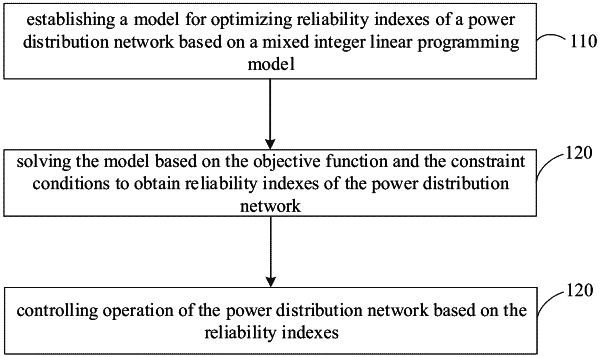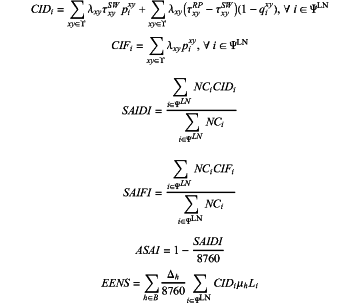| CPC H02J 3/001 (2020.01) [G05B 17/02 (2013.01); G06F 17/12 (2013.01); H02J 2203/20 (2020.01)] | 17 Claims |

|
1. A power distribution network reliability index calculation method based on mixed integer linear programming, comprising:
determining installation status of components, fault isolation, load transformation supply and action rules of fault recovery when there is a branch fault of the power distribution network, wherein the components include circuit breakers and switches installed at the end of each branch, which are used to isolate the faulty branch circuits and reconfigure the network after a branch circuit failure, and to recover the original power supply network structure after the faulty branch is repaired;
establishing a model for optimizing reliability indexes of a power distribution network based on a mixed integer linear programming model, wherein the model comprises an objective function and constraint conditions, the objective function is for minimizing a system average interruption duration index (SAIDI);
solving the model based on the objective function and the constraint conditions to obtain reliability indexes of the power distribution network; and
determining the reliability of the power distribution network based on the reliability indexes, and controlling operation of the power distribution network based on the reliability indexes;
wherein establishing the model for optimizing reliability indexes of the power distribution network based on the mixed integer linear programming model comprises:
determining the objective function; and
determining the constraint conditions;
wherein the constraint conditions comprise a reliability index calculation constraint;
wherein the reliability index calculation constraint is determined by:
 where, CIDi represents a customer interruption duration of a node i, λxy represents an annual fault rate of a branch xy, τxySW represents an interruption period of fault isolation action of the branch xy, τxyRP represents an interruption period of fault restore of the branch xy, CIFi represents a customer interruption frequency of the node i, NCi represents a given number of customers of the node i, SAIDI represents a system average interruption duration index, SAIFI represents a system average interruption frequency index, ASAI represents a system average service availability index, EENS represents an expected energy not supplied, B represents a collection of all load levels, Δh represents a number of hours lasted per year for a load level h, μh≤1 represents a peak load ratio of the level h, and Li represents a peak load ratio of the node i.
|